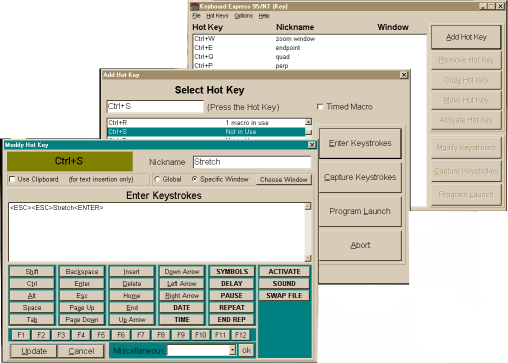Command Speed
Comments by:
Odin Cary
Contents:
Article 1: AutoCAD Accelorators ---- Article
2: Keyboard Express 95/NT
This is the first in a series of
articles I will write about command speed enhancements that I
have come across and feel have significantly affected my
performance.
From the very first days with
AutoCAD, I found the general interface with computers clumsy,
lacking in intuitive structure and generally organically
inhospitable. But, I am still using a mouse and a rectangular
keyboard and looking into a flat screen with millions of pixels
attempting to look 3-dimensional. We seem to crave a 3D
interface.
My point is that we all seem to
struggle with our interfaces and therefore are always looking for
better and faster ways to interact with it. I found keyboard
macro’s to be the fastest way of running AutoCAD back in the
DOS days and though I am quickly becoming a fan of buttons and
palettes, I still like my macros. One of the best things about
macros is that you can invoke commands without moving your
pointing device away from the object(s) you are currently working
on.
Article #1
For Windows ’95 there is a
carry over program from 3.x called "Recorder.exe" that
I found particularly handy but, unfortunately, NT does not
support the "Recorder.exe" and I suspect that it will
not be supported in Win’98.
One solution is to take all of my
former macros and turn them into little LISP routines.
Another solution is to lean more
on Alias routines in the ACAD.PGP file.
But, what I really miss about my
macros, was the ability to use Shift, Ctrl and Alt in conjunction
with any other keyboard key to invoke a command.
The solution I found is to use
AutoCAD’s Accelerator Keys; defined in a small area near the
bottom of the ACAD.MN? files. I suggest that you modify the
ACAD.MNS file because then you can always restore the original
menu from the ACAD.MNU file should you make a serious mistake.
You can locate this file in the SUPPORT folder of your R14 and
AutoCAD R13 (under COM). You can open it with most text
processors, but be careful when you save it that you don’t
accidentally convert it to non-ASCII code; i.e., save it as
"raw" DOS text.
When you have written your
accelerator(s), reload AutoCAD or if you are familiar with the
MENU command, reload the changed menu and test your work.
In the ACAD.MNS file, you should
see a section labeled "****ACCELERATORS" with some of
the default keyboard macros defined.
One macro or
"Accelerator" that you might like is:
[CONTROL+"T"]_toolbar
This will invoke your toolbar
dialogue box so you can bring up your palettes faster.
And here is my new favorite
addition to my set of "Accelerators":
[SHIFT+"S"]$M=$(if,$(and,$(getvar,OSMODE),3071),'_OSMODE
0,'_OSMODE 3071)
This will turn your OSNAP toggle
on and off so you don’t have to go down to the status bar
and double pick. The number "3071" corresponds to the
osnap modes (endpoint, midpoint, etc.) that I want on. To set a
different set of osnap modes than my choice, you can use the sum
of all modes which is 4095 (all osnap modes on) or chose specific
settings. To learn more about this, use the AutoCAD help menu and
go to "OSMODE".
Article #2
Recently I came across another
Keyboard Macro Recording program that works with Windows '95 and
NT 4.0. This Tips & Ttricks lead comes
courtesy of Wayne Leong, AIA - Leong and Associates.
The downloadable shareware program
is call "Keyboard Express 95/NT" and you can get it by
visiting http://www.keyboardexpress.com/ . The price is $29.95.
| I found this program to
be one of those "no-brainer" down loads,
installs and operators. The only problem that I found in
using this macro recording program was that it ran a bit
slow on my 200Mhz Pentium and according to Wayne that was
a problem in his office as well. According to Wayne,
however, speed was not a problem on his higher speed
Pentium Pro's and PII 's. |
 |
The first thing that I discovered
after playing with this program was that if I "Capture
Keystrokes" directly in AutoCAD R14 the performace on recall
from Keyboard Express 95/NT was much more reliable and zippy.
The second thing that I discoverd
is that the program installs with a setting that requires Ctrl +
Right-mouse-click for activation. I wanted this application to
indicate activation on my Taskbar so I could tell if it was up
and running or not and I made this possible by going to: Options
>> Program Activate Key >> None.
